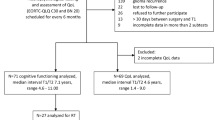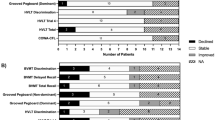Abstract
Diffuse WHO grade II (GIIG) may be unresectable when involving critical structures. To assess the feasibility and functional tolerance (cognition and quality of life) of an original therapeutic strategy combining neoadjuvant chemotherapy followed by surgical resection for initially inoperable GIIG. Ten patients underwent Temozolomide for unresectable GIIG, as initial treatment or at recurrence after previous partial resection, due to invasion of eloquent areas or bi-hemispheric diffusion preventing a total/subtotal removal. Functional outcome after both treatments was assessed, with evaluation of seven cognitive domains. Chemotherapy induced tumor shrinkage (median volume decrease 38.9%) in ipsilateral functional areas in six patients and in the contralateral hemisphere in four. Only four patients had a 1p19q codeletion. The tumor shrinkage made possible the resection (mean extent of resection 93.3%, 9 total or subtotal removals) of initially inoperable tumors. Postoperatively, three patients had no deficits, while verbal episodic memory and executive functions were slightly impaired in seven patients. However, global quality of life was roughly preserved on the EORTC QLQ C30 + BN 20 (median score: 66.7%). Role functioning score was relatively reduced (median score: 66.7%) whereas KPS was preserved (median score: 90, range 80–100). Seven patients became seizure-free while three improved. This combined treatment is feasible, efficient (surgery made possible by neoadjuvant chemotherapy) and well-tolerated (preservation of quality of life, no serious cognitive disturbances). Cognitive deficits seem mostly related to tumor location. Because KPS is not reliable enough, a detailed neuropsychological assessment should be systematically performed in GIIG.



Similar content being viewed by others
References
Berger MS, Deliganis AV, Dobbins J, Keles GE (1994) The effect of extent of resection on recurrence in patients with low grade cerebral hemisphere gliomas. Cancer 74:1784–1791
Duffau H, Lopes M, Arthuis F et al (2005) Contribution of intraoperative electrical stimulations in surgery of low grade gliomas: a comparative study between two series without (1985–96) and with (1996–2003) functional mapping in the same institution. J Neurol Neurosurg Psychiatry 76:845–851
Keles GE, Lamborn KR, Berger MS (2001) Low-grade hemispheric gliomas in adults: a critical review of extent of resection as a factor influencing outcome. J Neurosurg 95:735–745
Smith JS, Chang EF, Lamborn KR et al (2008) Role of extent of resection in the long-term outcome of low-grade hemispheric gliomas. J Clin Oncol 26:1338–1345
Soffietti R, Baumert BG, Bello L et al (2010) Guidelines on management of low-grade gliomas: report of an EFNS-EANO* Task Force. Eur J Neurol 17:1124–1133
van den Bent MJ, Afra D, de Witte O et al (2005) Long-term efficacy of early versus delayed radiotherapy for low-grade astrocytoma and oligodendroglioma in adults: the EORTC 22845 randomised trial. Lancet 366:985–990
Douw L, Klein M, Fagel SS et al (2009) Cognitive and radiological effects of radiotherapy in patients with low-grade glioma: long-term follow-up. Lancet Neurol 8:810–818
Whittle IR (2004) The dilemma of low grade glioma. J Neurol Neurosurg Psychiatry 75:31–36
Buckner JC, Gesme D Jr, O’Fallon JR et al (2003) Phase II trial of procarbazine, lomustine, and vincristine as initial therapy for patients with low-grade oligodendroglioma or oligoastrocytoma: efficacy and associations with chromosomal abnormalities. J Clin Oncol 21:251–255
Mason WP, Krol GS, DeAngelis LM (1996) Low-grade oligodendroglioma responds to chemotherapy. Neurology 46:203–207
Soffietti R, Rudà R, Bradac GB, Schiffer D (1998) PCV chemotherapy for recurrent oligodendrogliomas and oligoastrocytomas. Neurosurgery 43:1066–1073
Brada M, Viviers L, Abson C et al (2003) Phase II study of primary temozolomide chemotherapy in patients with WHO grade II gliomas. Ann Oncol 4:1715–1721
Hoang-Xuan K, Capelle L, Kujas M et al (2004) Temozolomide as initial treatment for adults with low-grade oligodendrogliomas or oligoastrocytomas and correlation with chromosome 1p deletions. J Clin Oncol 22:3133–3138
Pace A, Vidiri A, Galie E et al (2003) Temozolomide chemotherapy for progressive low-grade glioma: clinical benefits and radiological response. Ann Oncol 14:1722–1726
Quinn JA, Reardon DA, Friedman AH et al (2003) Phase II trial of temozolomide in patients with progressive low-grade glioma. J Clin Oncol 21:646–651
Liu R, Solheim K, Polley MY et al (2009) Quality of life in low-grade glioma patients receiving temozolomide. NeuroOncol 11:59–68
Duffau H, Taillandier L, Capelle L (2006) Radical surgery after chemotherapy: a new therapeutic strategy to envision in grade II glioma. J Neurooncol 80:171–176
Mandonnet E, Jbabdi S, Taillandier L et al (2007) Preoperative estimation of residual volume for WHO grade II glioma resected with intraoperative functional mapping. Neuro-Oncology 9:63–69
Ius T, Angelini E, Thiebaut de Schotten M, Mandonnet E, Duffau H (2011) Evidence for potentials and limitations of brain plasticity using an atlas of functional resectability of WHO grade II gliomas: towards a “minimal common brain”. NeuroImage 56:992–1000
Duffau H, Capelle L, Sichez N et al (2002) Intraoperative mapping of the subcortical language pathways using direct stimulations. An anatomo-functional study. Brain 125:199–214
Duffau H (2005) Intraoperative cortico-subcortical stimulations in surgery of low-grade gliomas. Expert Rev Neurother 5:473–485
Deloche G, Hannequin D (1997) Test de dénomination orale de 80 images : DO80. Edition du Centre de Psychologie Appliquée, Paris
Metz-Lutz MN, Kremin H, Deloche G et al (1991) Standardisation d’un test de dénomination orale : contrôle de l’âge, du sexe et du niveau de scolarité chez des sujets adultes normaux. Rev Neuropsychol 1:73–95
Ojemann G, Ojemann J, Lettich E, Berger M (1989) Cortical language localization in left, dominant hemisphere. An electrical stimulation mapping investigation in 117 patients. J Neurosurg 71:316–326
Duffau H, Gatignol P, Mandonnet E, Capelle L, Taillandier L (2008) Intraoperative subcortical stimulation mapping of language pathways in a consecutive series of 115 patients with Grade II glioma in the left dominant hemisphere. J Neurosurg 109:461–471
Gil-Robles S, Duffau H (2010) Surgical management of World Health Organization grade II gliomas in eloquent areas: the necessity of preserving a margin around functional structures? Neurosurg Focus 28(2):E8
Aaronson NK, Ahmedzai S, Bergman B et al (1993) The European organization for research and treatment of cancer QLQ-C30: a quality-of-life instrument for use in international clinical trials in oncology. J Natl Cancer Inst 85:365–376
Beck AT, Steer RA, Brown GK (1998) Inventaire de Dépression de Beck (BDI-II), deuxième ed. Éditions du Centre de Psychologie Appliquée (ECPA), Paris (version 2)
Schiff D, Brown PD, Giannini C (2007) Outcome in adult low-grade glioma: the impact of prognostic factors and treatment. Neurology 69:1366–1373
Spena G, Garbossa D, Barletta L, Prevost C, Versari P (2010) Preoperative chemotherapy for infiltrative low-grade oligoastrocytoma: a useful strategy to maximize surgical resection -case report. Neurol Med Chir (Tokyo) 50:410–413
Kaufmann M, Hortobagyi GN, Goldhirsch A et al (2006) Recommendations from an international expert panel on the use of neoadjuvant (primary) systemic treatment of operable breast cancer: an update. J Clin Oncol 24:1940–1949
Vergote I, van Gorp T, Amant F, Neven P, Berteloot P (2005) Neoadjuvant chemotherapy for ovarian cancer. Oncology (Williston Park) 19:1615–1622
Klug C, Wutzl A, Kermer C et al (2005) Preoperative radiochemotherapy and radical resection for stages II–IV oral and oropharyngeal cancer: outcome of 222 patients. Int J Oral Maxillofac Surg 34:143–148
Duffau H (2008) Brain plasticity and tumors. Adv Tech Stand Neurosurg 33:3–33
Brown PD, Buckner JC, O’Fallon JR et al (2003) Effects of radiotherapy on cognitive function in patients with low-grade glioma measured by the folstein mini-mental state examination. J Clin Oncol 21:2519–2524
Klein M, Heimans JJ, Aaronson NK et al (2002) Effect of radiotherapy and other treatment-related factors on mid-term to long-term cognitive sequelae in low-grade gliomas: a comparative study. Lancet 360:1361–1368
Mackworth N, Fobair P, Prados MD (1992) Quality of life self-reports from 200 brain tumor patients: comparisons with Karnofsky performance scores. J Neurooncol 14:243–253
Kaloshi G, Benouaich-Amiel A, Diakite F et al (2007) Temozolomide for low-grade gliomas: predictive impact of 1p/19q loss on response and outcome. Neurology 68:1831–1836
Taillandier L, Duffau H (2009) Epilepsy and insular grade II gliomas: an interdisciplinary point of view from a retrospective monocentric series of 46 cases. Neurosurg Focus 27(2):E8
Rudà R, Trevisan E, Soffietti R (2010) Epilepsy and brain tumors. Curr Opin Oncol 22:611–620
Folstein MF, Folstein SE, McHugh PR (1975) “Mini-mental state”. A practical method for grading the cognitive state of patients for the clinician. J Psychiatry Res 12(3):189–198 (Traduction française) : version consensuelle GRECO, Derouesne C, Poitreneau J, Hugonot L, Kalafat M, Dubois B, Laurent B, Presse Med. 1912, pp 1141–1148, 1999
Derouesné C, Poirteneau J, Hugonot L, Kalafat M, Dubois B, Laurent B (1999) Le mini-mental state examination (MMSE) : un outil pratique pour l’évaluation de l’état cognitif des patients par le clinicien. Presse Med 28:1141–1148
Mackinnon A, Mulligan R (2005) The estimation of premorbid intelligence levels in French speakers. Encephale 31:31–43
Oldfield RC (1971) The assessment and analysis of handedness: the Edinburgh inventory. Neuropsychologia 9:97–113
Wechsler D (2000) WAIS-III. Echelle d’intelligence de Wechsler pour adultes, Troisième edition edn. Edition du Centre de Psychologie Appliquée, Paris
Reitan RM, Wolfson D (1985) The Halstead–Reitan neuropsycholgical test battery: therapy and clinical interpretation. Neuropsychological Press, Tucson
Godefroy O. GREFEX. Fonctions exécutives et pathologies neurologiques et psychiatriques. Évaluation en pratique clinique. Solal Marseille, 2008
Gauthier L, Dehaut F, Joanette Y (1989) The bells test: a quantitative and qualitative test for visual neglect. Int J Clin Neuropsychol 11:49–53
Rousseaux M, Beis JM, Pradat-Diehl P et al (2001) Presenting a battery for assessing spatial neglect. Norms and effects of age, educational level, sex, hand and laterality. Rev Neurol (Paris) 157:1385–1400
Rey A (1941) L’examen psychologique dans les cas d’encéphalopathie traumatique. Arch Psychol 28:328–336
Delbecq-Derouesné J, Beauvois M (1989) Memory processes and aging: a defect of automatic rather than controlled processes? Arch Gerontol Geriatrics 1:121–150
Buschke H (1973) Selective reminding for analysis of memory and learning. J Verbal Learning Verbal Behav 12:543–550
Van der Linden M, Coyette F, Poitrenaud J (2004) L’épreuve de rappel libre/rappel indicé à 16 items (RL/RI-16). In M. Van der Linden, S. Adam, A. Agniel, C. Baisset-Mouly & al, members of GRENEM (Eds). L’évaluation des troubles de la mémoire: Présentation de quatre tests de mémoire épisodique (avec leur étalonnage). Marseille, Solal pp 5–47
Grégoire J, Van der Linden M (1997) The effect of age on forward and backward digit spans. Aging, Neuropsychol Cogn 4:140–149
Thuillard F, Assal G (1991) Données neuropsychologiques chez le sujet âgé normal. In: Habib M, Joanette Y, Puel M (eds) Démences et syndromes démentiels, approche neuropsychologique. Masson, Paris, pp 125–133
Warrington EK, James M (1991) The visual object and space perception battery (VOSP). Bury St Edmunds, England
Agniel A, Joanette Y, Doyon B, Duchein C (1987) Protocole d’évaluation des gnosies visuelles Montréal-Toulouse (PEGV) Laboratoire Th-Alajouanine. Centre de recherche du Centre Hospitalier Côte-des-Neiges, Montréal
Burgess P, Shallice T (1997) The Hayling and Brixton Tests. Test manual Bury St Edmunds. Thames Valley Test Company, UK
Stroop JR (1935) Studies of interference in serial verbal reactions. J Exp Psychol 6:643–662
Author information
Authors and Affiliations
Corresponding author
Rights and permissions
About this article
Cite this article
Blonski, M., Taillandier, L., Herbet, G. et al. Combination of neoadjuvant chemotherapy followed by surgical resection as a new strategy for WHO grade II gliomas: a study of cognitive status and quality of life. J Neurooncol 106, 353–366 (2012). https://doi.org/10.1007/s11060-011-0670-x
Received:
Accepted:
Published:
Issue Date:
DOI: https://doi.org/10.1007/s11060-011-0670-x




